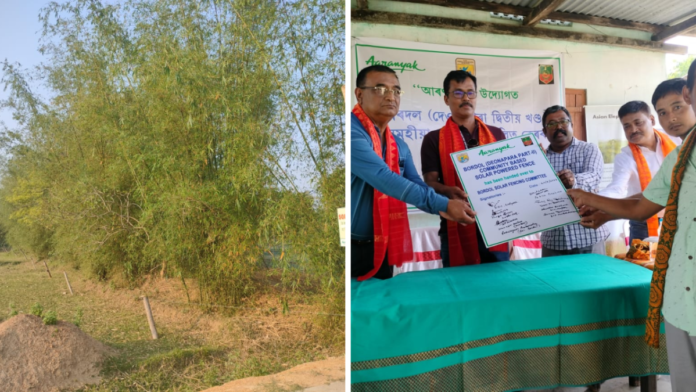In a major move to address the ongoing human-elephant conflict in Assam, villagers in the Goalpara district have been provided with innovative solar fencing solutions. This initiative aims to protect local communities from the frequent intrusions of elephants into agricultural fields while simultaneously safeguarding the elephants themselves. As human-wildlife conflict escalates due to habitat loss and increasing human populations, this solar fencing initiative presents a promising approach to creating a harmonious coexistence between humans and elephants.
Understanding the Human-Elephant Conflict
The human-elephant conflict in Assam has been a pressing issue for years, especially in rural areas like Goalpara. With the rapid expansion of agriculture and urbanization, elephants often venture into villages and farmlands in search of food, leading to destructive encounters. These interactions not only threaten the livelihoods of local farmers but also result in injuries and fatalities among both humans and elephants.
In Assam, where a significant population of elephants resides, the challenge is twofold. While the elephants are protected under wildlife conservation laws, the locals bear the brunt of the damages caused by these majestic animals. Consequently, there has been a pressing need for effective measures to mitigate this conflict.
The Solar Fencing Initiative
To tackle this pressing issue, the local government and wildlife conservation organizations have collaborated to install solar fences around agricultural fields in the Goalpara district. This initiative involves the following key aspects:
1. Technology Integration
The solar fencing system operates on the principle of creating a low-voltage electric barrier that deters elephants from entering cultivated areas. The installation of these solar fences is not only cost-effective but also environmentally friendly, as it relies on renewable energy. By utilizing solar power, the system ensures continuous operation without dependence on grid electricity, making it ideal for rural areas.
2. Community Engagement
The success of the solar fencing initiative hinges on active community participation. Local villagers have been involved in the planning and implementation phases, ensuring that their insights and concerns are addressed. Awareness campaigns and training sessions have been organized to educate the villagers on the proper use and maintenance of the solar fencing systems.
3. Enhanced Safety Measures
The installation of solar fences is expected to significantly reduce human-elephant encounters in the area. By creating a physical barrier, the fences minimize the chances of elephants raiding crops, thereby protecting farmers’ livelihoods. Additionally, this proactive approach reduces the risk of injury to both humans and elephants, fostering a safer environment for all.
4. Long-term Sustainability
The solar fencing initiative is designed with long-term sustainability in mind. Regular maintenance and monitoring of the fencing systems will be conducted to ensure their efficacy over time. Moreover, the project encourages the villagers to take ownership of the solar fences, instilling a sense of responsibility toward wildlife conservation.
Benefits to Local Communities
The introduction of solar fencing brings numerous benefits to the villagers in Goalpara:
- Protection of Crops: By preventing elephants from entering agricultural fields, farmers can safeguard their crops, leading to improved food security and increased income.
- Reduction in Conflicts: With fewer encounters between humans and elephants, the likelihood of injuries or fatalities diminishes, fostering a more peaceful coexistence.
- Awareness and Education: The initiative has opened avenues for educating the community about wildlife conservation and the importance of protecting their natural heritage.
- Economic Opportunities: With reduced crop loss, farmers can invest more in their agricultural practices, potentially leading to better yields and financial stability.
The Role of Government and NGOs
The successful implementation of the solar fencing initiative in Goalpara is the result of collaborative efforts between government agencies and non-governmental organizations (NGOs). The Assam Forest Department, along with wildlife conservation groups, has been instrumental in raising awareness, securing funding, and overseeing the installation of the solar fences.
This partnership highlights the importance of multi-stakeholder engagement in addressing human-wildlife conflicts. By working together, governments, NGOs, and local communities can develop sustainable solutions that benefit both people and wildlife.
The success of the solar fencing project in Goalpara has the potential to serve as a model for other regions in Assam and beyond, where human-elephant conflicts are prevalent. As awareness grows and more communities adopt similar measures, the hope is to reduce tensions between humans and elephants significantly.
Furthermore, the initiative can pave the way for the development of additional wildlife management strategies that prioritize coexistence. By investing in technology, education, and community engagement, we can foster a more harmonious relationship between humans and wildlife.
The implementation of solar fencing in Assam’s Goalpara district is a groundbreaking step toward mitigating human-elephant conflict. This innovative solution not only protects the livelihoods of local farmers but also ensures the safety of elephants, promoting a sustainable coexistence between humans and wildlife.




